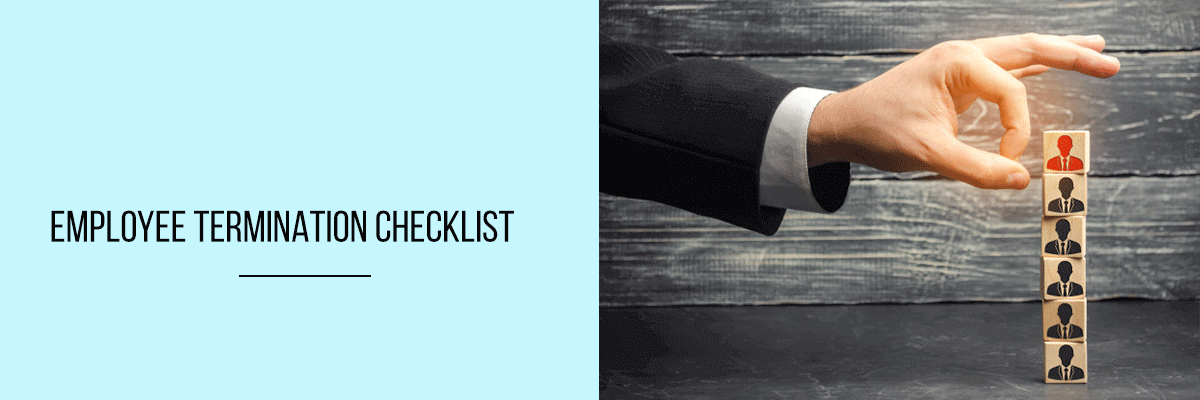Effective onboarding and employee termination are two of the most critical processes from an HR perspective. Onboarding helps new employees integrate into the company, adapt to the work environment, and start contributing quickly. On the flip side, employee termination is equally important—it ensures that when an employee leaves, the process is handled professionally, respectfully, and in a way that benefits both the employee and the company.
Employees are vital to an organization’s success, driving growth and maintaining day-to-day operations. However, when employees decide to move on to new opportunities, employers must manage their exit in a way that upholds the employee’s dignity while protecting the company’s interests. When an employee notifies you of their resignation or decision to terminate their employment, it’s essential to approach the process with care, ensuring that legal requirements and workplace courtesies are observed.



In this blog, we will walk through the key elements of an Employee Termination Checklist. While this checklist isn’t exhaustive, it will provide a solid foundation for handling employee exits smoothly, professionally, and in a way that minimizes disruptions for the company and the employee.
Employee Termination Procedure Checklist
When an employee decides to leave the company, it is crucial to follow a structured process to ensure that both the company’s and the employee’s interests are protected. A well-managed termination helps safeguard legal rights and ensures the employee leaves with a positive experience. Below is a comprehensive checklist to guide you through the employee termination process:
1. Documenting Incidents and Evidence for Termination Decisions
Before initiating the termination, ensure that you’ve thoroughly documented any incidents, performance issues, or violations that led to the decision. This documentation is vital for legal protection and provides evidence that justifies your decision. Keeping detailed records can help prevent potential claims of wrongful termination.
2. Scheduling and Conducting the Termination Meeting
Once the decision to terminate has been made, schedule a private termination meeting with the employee. In this meeting, communicate the decision respectfully and professionally. Explain the reasons for the termination clearly and give the employee an opportunity to ask questions. Prepare for emotional reactions, as this can be a difficult moment for the employee. Handling this meeting with empathy and professionalism is crucial to maintaining a positive relationship.
3. Providing an Official Termination Letter
Following the termination meeting, provide the employee with an official termination letter. This letter should include the effective date of termination, the reason for the decision, and any other relevant information. The termination letter serves as an official record of the event and ensures both parties are on the same page.
4. Handling Emotional Reactions During the Termination Meeting
Employee terminations can trigger emotional responses. As the employer or HR professional, it’s essential to remain calm and empathetic. Allow the employee to express their feelings, but keep the conversation focused on the facts. If necessary, offer support resources, such as career counseling or outplacement services, to help the employee through the transition.
5. Making Necessary Leaving Forms
Ensure that the employee completes all necessary exit paperwork. This includes forms related to the return of company property (keys, access cards, equipment, etc.), as well as any documentation necessary to finalize their departure. IT should disable the employee’s access to company systems, including login credentials, email accounts, and databases, to prevent unauthorized access.
6. Collecting Company Property
It is essential to collect all company property from the employee before they leave. This includes any electronics, documents, vehicles, or other assets that belong to the organization. Make sure the items are returned in good condition and properly accounted for in the company’s inventory.
7. Planning for Role Transition and Minimizing Workflow Disruption
To minimize disruption to the company’s operations, plan a smooth transition of the employee’s responsibilities. This may involve redistributing their workload among other team members, assigning a successor, or providing training for other employees. Communicate with your team to ensure everyone is prepared for the change and that no critical tasks are left unaddressed.
8. Exit Interview
An exit interview is a valuable opportunity to gather feedback from the departing employee. It helps identify any concerns or issues within the organization and provides insights into the employee’s reasons for leaving. This can help you make improvements to the workplace and prevent future turnover. Additionally, it allows you to ensure that the employee is leaving for positive reasons, like career advancement, rather than dissatisfaction with the company.
9. Settle Pending Payments
Ensure that all pending payments are processed and cleared before the employee’s final day. This includes settling outstanding salaries, unused leave balances, bonuses, or any other financial obligations owed to the employee. Providing a detailed final payment breakdown demonstrates the company’s transparency and commitment to closing the relationship on a positive note.
10. Ensuring Legal Post-Termination Requirements
Once the termination process is complete, ensure compliance with all legal post-termination requirements. This may include issuing final paychecks, providing information about unemployment benefits, and ensuring that any severance pay (if applicable) is processed correctly. Be sure to follow local laws to avoid potential legal complications.
11. Discussing the Termination with Key Staff Members
After the termination, it’s important to inform key staff members, especially those who work closely with the departing employee. Share the necessary details while maintaining confidentiality and professionalism. It’s important to avoid discussing the personal reasons for the termination and focus on the impact on the team and organization. This transparency helps maintain morale and ensures a smooth transition within the team.
12. Double-Check All Everything
Before finalizing the termination process, ensure that every step in the termination checklist has been completed. Cross-check that all required paperwork, exit interviews, and role transitions are handled properly. Verify that the employee has returned all company property, their access to company systems has been disabled, and all loose ends are tied up. A thorough review minimizes the risk of overlooked details and ensures a smooth departure.
It is crucial to carefully review the reason for an employee’s termination before finalizing the decision. Take the time to assess whether the termination is justified and supported by clear evidence. If any errors or misunderstandings have influenced the decision, this review process can help identify and address them. Such diligence not only protects the employee and the team from the consequences of wrongful termination but also safeguards the company from potential legal challenges. Moreover, avoiding wrongful termination reinforces the organization’s commitment to fairness, helps maintain employee trust, and preserves the company’s reputation in the industry.
Best Practices for Employee Termination
In addition to the checklist, following these best practices can help ensure that the termination process is handled with respect, consistency, and legal compliance:
1. Establish Your Termination Policy
From the very beginning, ensure that all employees are aware of the company’s termination policies. Communicate these policies during onboarding, and make sure employees understand the expectations for behavior and the consequences of any fireable offenses. Clear and consistent policies help prevent confusion and reduce the risk of legal issues later on. This policy will help you avoid issues that could negatively impact the company during termination.
2. Offer Resources to Support the Employee
When an employee is leaving, offering support can make the process smoother for both parties. This can include providing resources such as career counseling, job search assistance, or information on unemployment benefits. Offering support shows that the company cares about the employee’s well-being, even after they leave.
3. Severance Pay
If applicable, offer severance pay to the departing employee. Severance packages can help employees transition to their next opportunity and may be legally required, depending on the terms of their contract or local labor laws. Providing severance pay demonstrates a level of care for the employee and can help preserve a positive relationship.
If you want to learn more about human resource topics, enhance your knowledge, and learn from experts and their experiences, then check out our HR webinar page, which might help take your HR career to the next level. Our HR webinars are conducted by industry experts and also provide SHRM and HRCI credits, which can help advance your HR career.
We have an upcoming webinar that discusses how to retain your top talented employees. Be sure to check out this HR webinar!
Conclusion
Handling employee terminations with professionalism, empathy, and attention to legal requirements is essential for maintaining a positive work environment and protecting the company’s interests. By following this employee termination checklist and adhering to best practices, HR teams can manage the termination process smoothly, minimizing disruptions, and ensuring a respectful and professional exit for all parties involved.
This structured approach not only helps protect the organization legally but also leaves the departing employee with a positive impression, contributing to a healthy workplace culture.


